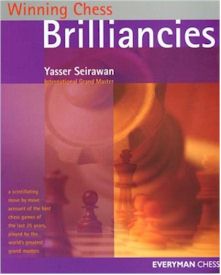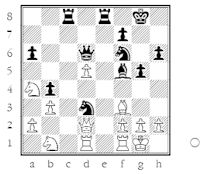Winning Chess Brilliancies 
 An Easytorecall Book Review
An Easytorecall Book Review
Winning Chess: Brilliancies
By GM Yasser Seirawan with Jeremy Silman Everyman Publishers 2003 £10.49
257 pages (July 15, 2003)
Book Review
by Graham Brown
THIS is the fourth and final book in the 'Winning Chess' series (although there was a fifth later "Winning Chess Openings" by request of the readers!) . You can find reviews for all the others at the Grandmaster Square website. In the first three books and especially the first, 'Play Winning Chess', Seirawan splits chess into four elements: Time, Force, Pawn Structure and Space. This was both elegant and instructional. But now he explains that it is time for these elements to come together in a more natural way. "Applying the tools of the trade subtly and simply appears natural and yet is satisfying because the results are brilliant."
So, Seirawan shows the four elements used in practice in 12 inspired games from the past generation. Each begins with an introduction describing the historical atmosphere of the time. We start in 1972 and the Fischer-Spassky match in Iceland. Seirawan had just begun learning chess one rainy summer in Seattle and this match caught his imagination. Seirawan describes in detail how important this 6th game was in terms of the psychology of the match and then we get the first move from Fischer, 1. c4. This gets a page and a half of comment and this sets the tone for the rest of the book.
23 pages later, Fischer has won a famous victory. The first time he had gone up in the match. "A stunned Boris Spassky joined with the audience after the game to applaud Fischer's victory." We have been taken through the game in great detail to show "an extraordinary technical achievement. Fisher played perfectly throughout, topping the game off at the end with a prosaic exchange sacrifice. Around the chess world, grandmasters were awed at the simplicity and precision of Fischer's play."
And so the book goes on. Next on the menu is Karpov-Korchnoi, and "Slaying the dragon". Seirawan says that later he joined Korchnoi's team for the 1981 match. "While driving through the Austrian Alps, I asked him how history would have changed had he won the 1974 match. He told me that Karpov would be in the car" Good interesting inside information - typical of this book.
So we have a dozen games annotated very deeply with prose upon prose explaining what is going on - often referring back to the four elements. But in this book they have come to life. We can see them used in the heat of battle and used in inspiring ways. We can see the result of the elements coming together to create more than the sum of their parts and we also see the rules broken, for good reason, occasionally.
But for a brilliant example of not breaking one of these 4 rules we need look no further than the famous Karpov v Kasparov game with that infamous knight on d3. (What a way to show the power of a knight in the middle of the board!) For fun I will take a look at a position from that game and consider the "space" element.
Seirawan's Space element is particularly interesting as he provides a fantastically quick way to decide if you have a space advantage. And to quantify it! Yes, it is almost like having access to a Fritz score of your position. This is useful as there are some additional rules that if you have a space advantage you should keep pieces on the board in general etc. It is also useful to know if your opponent has the space advantage so you can, for example, swap the pieces off or whatever. So lets apply it to this famous game to see if Kasparov is applying this element well!

All we need to do is to count the squares of the opponent's territory that each side attacks, assuming that territory to be each half of the board. In book 1 Seirawan does this to some positions and if the difference in the 2 scores is say 3 points he considers that a space advantage, and he gives plans for both sides.
So can Kasparov beat 3? Let us calculate for White first. Karpov's a4 knight attacks b6 and c5 that's 2 points. His d5 pawn attacks c6 and e6 that's 2 points. His Queen attacks g5 for 1 point. His Bishop attacks h5 and d5 that's 2 points. So Karpov has a total of 7 points. Kasparov's c8 rook attacks c4 c3 c2 and c1 that's 4 points. His e8 rook does the same job on the e-file that's another 4 points, a lead already! His b4 pawn and g4 pawn get 4 points his f6 knight earns 2 points, his queen 4 points and his bishop on f5 earns 4 points. And his knight on d3 earns 6 points by attacking b2, c1, e1, f2, f4 and b4. (c5 and e5 don't count because they are in Black's half of the board) Kasparov has 28 points. So therefore Kasparov has a space advantage of 21 points!! But of course this merely serves to emphasis the point of the book. It is not enough to know the rules – they should flow naturally from your fingertips. Kasparov got to a 21 space advantage by being Kasparov not by counting squares every move. Of course Kasparov would have been pleased to find he was 21 points up but this match was 4 years before the 1st book in this series!
There were 18 games prepared for the book but apparently they just ran out of space after 12. This is understandable as each game is a whole chapter and you really get all the flavours of each game in minute detail. My Assessment: this 4th book in a brilliant quartet is richly entertaining and educational - a great read.
This review was first published in Chess Today CT-1146.
Graham Brown is a Freelance Journalist, technical editor of Chess Today and co-author of the Batsford book Chess on the Web
Can't find it?
Try our search engines, price comparison and online auction pages.

